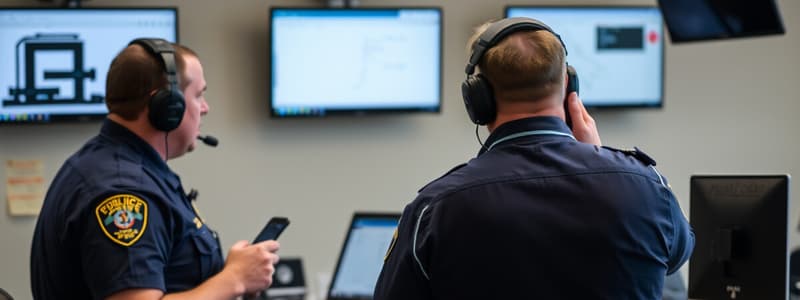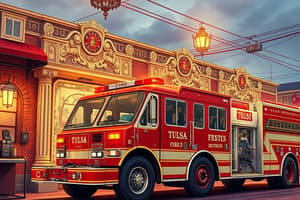Podcast
Questions and Answers
What happens if an alarm site has no permit?
What happens if an alarm site has no permit?
- The alarm user will not be authorized for police response with certain exceptions. (correct)
- No action is taken regardless of the situation.
- Police will always respond to assist the user.
- The alarm user is authorized for a police response.
Which of the following alarms will still prompt a police response regardless of permit status?
Which of the following alarms will still prompt a police response regardless of permit status?
- Residential alarms
- Panic and Hold Up alarms (correct)
- Door alarms without codes
- Motion sensor alarms
What must the primary officer do upon arriving at an alarm activation?
What must the primary officer do upon arriving at an alarm activation?
- Conduct a full investigation within ten minutes.
- Notify the dispatcher that they are at the scene. (correct)
- Wait for backup to arrive before checking the premises.
- Leave immediately if the alarm seems false.
If it is determined that an offense has occurred at an alarm site, what is the primary officer required to do?
If it is determined that an offense has occurred at an alarm site, what is the primary officer required to do?
Which unit is contacted for questions regarding an approved program participant of the Safe at Home Program?
Which unit is contacted for questions regarding an approved program participant of the Safe at Home Program?
What is one exception for police response when there is a suspended alarm permit?
What is one exception for police response when there is a suspended alarm permit?
What should the Communications Unit do upon receiving notification of an alarm activation?
What should the Communications Unit do upon receiving notification of an alarm activation?
Which guideline must officers follow after checking the premises during an alarm response?
Which guideline must officers follow after checking the premises during an alarm response?
What is prohibited when using Department digital photos?
What is prohibited when using Department digital photos?
Where should photographs taken with a Department digital camera be saved?
Where should photographs taken with a Department digital camera be saved?
What is the maximum number of biological samples DNA trained officers are allowed to collect?
What is the maximum number of biological samples DNA trained officers are allowed to collect?
What should DNA trained officers NOT do while at a crime scene?
What should DNA trained officers NOT do while at a crime scene?
What is the recommended action if there are issues with the 'CL Photo App'?
What is the recommended action if there are issues with the 'CL Photo App'?
What type of scenes are DNA trained officers primarily called to respond to?
What type of scenes are DNA trained officers primarily called to respond to?
Which of the following is NOT a responsibility of DNA trained officers?
Which of the following is NOT a responsibility of DNA trained officers?
How should photographs be uploaded after being saved to the 'CL Photo' folder?
How should photographs be uploaded after being saved to the 'CL Photo' folder?
What should be done before entering a hazardous structure or area?
What should be done before entering a hazardous structure or area?
How should individuals enter a hazardous area?
How should individuals enter a hazardous area?
When can occupants be evacuated from a hazardous structure?
When can occupants be evacuated from a hazardous structure?
What happens when there is an interagency conflict?
What happens when there is an interagency conflict?
What should a Department commander do if an interagency conflict arises?
What should a Department commander do if an interagency conflict arises?
Who is responsible for completing reports during a jurisdictional dispute?
Who is responsible for completing reports during a jurisdictional dispute?
What is the recommended approach to handle interagency conflicts?
What is the recommended approach to handle interagency conflicts?
What should other department members avoid during an interagency conflict?
What should other department members avoid during an interagency conflict?
What should an officer do if they believe the dispatched number of officers is insufficient?
What should an officer do if they believe the dispatched number of officers is insufficient?
What is the first action an officer should take when dispatched to a call?
What is the first action an officer should take when dispatched to a call?
What is the protocol if an officer observes a life-threatening situation while responding?
What is the protocol if an officer observes a life-threatening situation while responding?
When two one officer cars are dispatched, what should they do if they suspect a connection to a crime?
When two one officer cars are dispatched, what should they do if they suspect a connection to a crime?
What should an officer do if they are not needed at the scene after response?
What should an officer do if they are not needed at the scene after response?
What action should an officer take if they are unable to respond promptly after being dispatched?
What action should an officer take if they are unable to respond promptly after being dispatched?
If an officer is standing by while waiting for assistance, what is one of their responsibilities?
If an officer is standing by while waiting for assistance, what is one of their responsibilities?
How should officers behave if more than one officer is dispatched to a call?
How should officers behave if more than one officer is dispatched to a call?
What type of evidence should not limit the number of samples collected at a robbery scene?
What type of evidence should not limit the number of samples collected at a robbery scene?
Which of the following tasks requires the involvement of a CSI rather than a DNA trained officer?
Which of the following tasks requires the involvement of a CSI rather than a DNA trained officer?
What should an officer do when determining that tracking is necessary at a scene?
What should an officer do when determining that tracking is necessary at a scene?
Who should be contacted to request the use of a canine team?
Who should be contacted to request the use of a canine team?
Which of the following information is NOT required when notifying the Drug Enforcement Unit after a canine team detects a positive narcotic hit?
Which of the following information is NOT required when notifying the Drug Enforcement Unit after a canine team detects a positive narcotic hit?
What is a key responsibility of officers at a scene when evidence recovery is necessary?
What is a key responsibility of officers at a scene when evidence recovery is necessary?
What type of evidence processing can be conducted by officers without calling a CSI?
What type of evidence processing can be conducted by officers without calling a CSI?
When can a DNA trained officer refer questions to CSI?
When can a DNA trained officer refer questions to CSI?
Flashcards are hidden until you start studying
Study Notes
Communications and Officer Dispatch
- Allows monitoring of officer locations to prevent single-officer dispatch on calls requiring multiple units.
- Any officer aware of potential insufficient officer presence must request additional dispatch.
Response Protocols for Officers
- Officers must respond promptly to dispatched calls; failure to do so must be communicated to dispatchers.
- Standby protocol includes one officer maintaining safe observation while waiting for assistance.
- Primary officer must notify dispatch upon arrival on scene and may hold radio communication if needed.
- In life-threatening situations, initial officers can request emergency assistance (code one) and approach cautiously to prevent injuries.
Handling Alarm Calls
- No police response authorized for alarm sites without valid permits, except for critical infrastructures, panic, or hold-up alarms, or if unauthorized presence is reported.
- Upon arriving at alarm activation, officers must check the premises according to established guidelines.
- If an offense occurs, relevant reports must be filed, and attempts should be made to notify responsible parties.
Evidence Collection and Documentation
- Digital photos must be saved and uploaded to designated folders and apps within departmental systems.
- DNA-trained officers focus on property crimes and can document scenes for biological evidence, but sample collection should be limited to three unless necessary.
- All officers trained in evidence recovery should not request DNA officers merely to collect evidence.
Use of Canine Teams
- Canine teams available for assistance 24/7; requests should go through the Communications Unit.
- Officers must secure the area during canine searches/tracking to prevent suspect escape.
- Positive narcotic alerts require notification of the Drug Enforcement Unit with specifics on recovered substances and suspects.
Emergency Response in Hazardous Areas
- Officers must notify dispatch when entering hazardous structures and should operate in pairs for safety.
- Occupants can only be evacuated upon orders from the Fire Department unless immediate danger justifies otherwise.
Interagency Conflicts Resolution
- Department commanders must respond quickly to unresolved interagency issues, determine resolution methods, and submit communication regarding the incident.
- Jurisdictional disputes typically resolved by Kansas City officers through standard reporting protocols.
- Diplomatic resolution methods mandated for interagency conflicts; unauthorized communication between departments is prohibited.
Studying That Suits You
Use AI to generate personalized quizzes and flashcards to suit your learning preferences.


